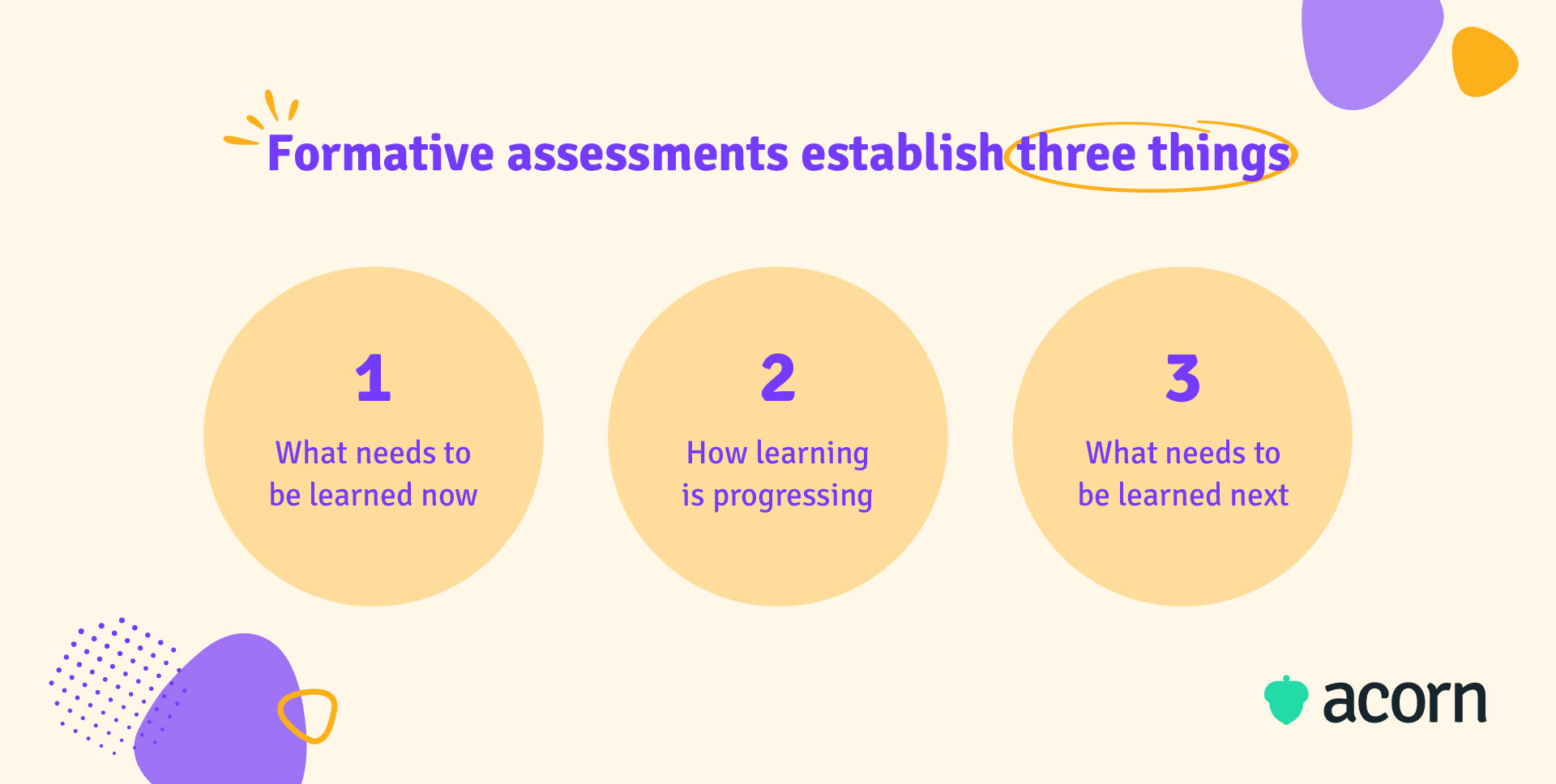Formative Assessments in the Workplace: Business Benefits & Examples for Employee Development
Reading Time:

Lead the pack with the latest in strategic L&D every month— straight to your inbox.
SubscribeFormative assessments aren’t just for students, and knowledge checks for corporate learners don’t just have to test grades.
We’ve all heard the complaint (or complained) that end of year exams only test memory. We won’t expand on that here, but we will say that testing what people have learnt after the instructional period has passed is kind of like making up a recipe and only tasting your creation when it’s done. That’s why we taste while we’re cooking—or use formative assessments.
The formative assessment is usually associated with student learning, but we’ve found that it fits the workplace environment just as nicely.
In this article, we talk about how formative assessments are the L&D leader’s secret weapon in creating strategically impactful training programs.
What is a formative assessment?
A formative assessment is a process in the learning experience where the ultimate goal is to help learners identify and improve capability gaps. Unlike other assessments that measure and assign a grade to performance, formative assessments evaluate what has been learned so far in order to provide feedback.
Assessment expert Robert Stake probably has the most apt description:
“When a cook tastes the soup, that’s formative assessment. When the customer tastes the soup, that’s summative assessment.”
Typically, the formative assessment is used to improve student achievement by assessing the teaching and learning process. It’s then topped off with summative assessments that evaluate the culmination of student understanding. (Takes us back to pre-exam jitters.) Once just a tool for teachers to test their students’ understanding, formative assessments have their place in the employee training lexicon.

How can formative assessments be used in the workplace?
Maybe you’ve heard the term formative appraisal or formative evaluation. Both are iterations of what we’re talking about. All are necessary in training that have behavioural change pegged as the outcome.
Employee training and classroom education have, in the past, shared a similar learning strategy: Teach the same thing to everyone, regardless of factors like existing skill, comprehension and learning preferences. This ignores the pivotal part: Employees (or students) understand the learning content.
Our point is that if you look at training after the fact, you miss opportunities to provide L&D that is impactful for employees and organisation.
There are a few ways you can utilise formative assessments in the workplace.
- Drive continuous skills gaps analyses
- Inform post-training enablement
- Improve training design.
Continuous gap analysis
We’ve talked over and over and over and over again about the importance of starting any training with a needs analysis. It’s essentially a scan of the jobs and capabilities you have currently, vetted against your ideal future state. You want to continually consider the emerging skills and roles that will impact the bottom line; automation, as an example, will change job responsibilities or make them redundant.
Gaps will consistently emerge, even if you’re planning for them (and your plans should account for that). That’s why consistently assessing your means for closing those gaps—i.e. training—keeps you ahead of the curve.
Most learning solutions make that hard to effectively do. They focus on skills (which expire quickly and can’t be aligned with business needs) and pushing more (and potentially irrelevant) content onto learners. We created the performance learning management system (PLMS) to counteract this. It’s the only solution that maps learning content to capabilities, so you can develop, assess and report on capability gaps in real time.
Say a manager (who’s picked for succession planning) gets put in the same generic course on leadership as their junior associate successor, despite already acquiring that knowledge in the three years they’ve worked for the organisation. And while you may think the junior is still benefitting, the types of content and hard deadlines are clashing with their learning style and workload.
Formative assessments ensure that those gaps are being closed with truly tailored training. And when training is tailored to skills gaps, you can:
- More clearly delineate business impacts from L&D
- Create individual capability development plans
- Focus L&D strategies and resources, saving time and money
- Develop mission-critical skills, knowledge and behaviours
- Better assess and manage performance.
Inform post-training enablement
It’s not just about academic achievement in training; you want to affect real change.
Feedback is a core part of the formative assessment process. It’s also the key driver of performance management. In either case, feedback should steer capability development and uncover issues or hurdles in a learner’s journey.
As formative assessments are often low stakes, they are useful in managing skills application. Consider an employee who’s undertaking leadership development. There are multiple behavioural capabilities they’ll need to develop (emotional intelligence, conflict resolution, delegation) and which can be difficult to switch one’s mindset to.
You could get the employee to run a meeting for their team. A manager can watch over to ascertain how they flex (if at all) their developing capabilities. They may even check in with the team to gauge how the employees’ peers thought they conducted themselves. Low stakes, manageable and allows for course correction in real time.
Improve training design
The goal of formative assessment is to collect information that can be used to improve learning while it’s happening.
Say you’ve got a program in your learning management system (LMS) that uses multiple course formats, like videos, readings and quizzes. You want to know what the most helpful and consumed formats are, as the videos are pulled from a third party content provider and you need to justify the purchase. At the completion of every course, there could be a question such as, “How would you rate the delivery of this course?” or “Which course have you found most engaging so far?” Both of these give you enough aggregate information to adjust the program while learners are still in it (by, say, swapping a reading for another video). This makes the L&D team’s life a lot easier in the main.
3 formative assessment examples
We’ve covered a few already, but let’s look at some more examples of formative assessments.
One-on-ones
Making these a regular (weekly, fortnightly, monthly) calendar appointment only builds on manager-employee relationships. In a hybrid working world, we’re often talking via message or email—which sacrifices a bit of that human touch.
Done regularly, one-on-ones:
- Allow managers and direct reports to prioritise workloads
- Demonstrate that employers care for their people
- Provide a no-judgement environment to raise issues
- Get to the heart of performance issues.
An employee may be facing a health issue that they don’t want to share with the team, though it’s impacting their work. A private discussion with their manager can see the two routinely assess workload based on the employee’s needs that week.
Pulse surveys
Sentiments can vary from week to week. That’s why a pulse survey is a handy formative assessment. Maybe there’s a program all employees have to do, like OH&S. A pulse survey with 3–6 questions every few weeks gathers feedback en masse, making it easy to find patterns in responses.
Using an LMS or email means you can automate the process, too. If the survey pops up at the end of a module, you’ll get feedback in the moment that employees may forget later on.
Self-assessments
Being able to self assess one’s capabilities and capacity to learn is a sign of a growth mindset. It’s the determining factor of a person’s ability to actually learn new things.
The self assessment:
- Encourages employees to set stretch goals within your organisation and own learning
- Contributes to holistic 360 feedback and performance reviews
- Gets employees critically thinking about how their job performance contributes to business outcomes.

Benefits of formative employee assessment
Formative assessment strategies really boost your workplace cred. Aside from catching weaknesses as they crop up, assessments for formative purposes are an integral part of creating a mature learning culture.
Timely feedback
Not just ongoing, but actually timely and personalised. There are moments on a daily basis when employees require more information than they currently have for a task. That could be when:
- Learning an entirely new task
- Lacking formal instruction or a knowledge base
- Recalling prior knowledge
- Unexpected events occur
- A change in practice or techniques emerge, such as new software being introduced.
Compared to summative assessments like annual reviews, continuous feedback means that learning interventions actually intervene before detrimental habits and behaviours are deep rooted.
Deepen managerial skills
People rarely possess stellar leadership capabilities off the bat. Your middle managers also have the biggest impact on employee satisfaction, so it’s important to have the right people in those roles. A formative assessment is a two-way street, meaning that managers can get real time feedback on their leadership style while practicing it. As feedback is being given exactly when it’s needed, your conflict management systems are also strengthened.
Self-guided learning
Self-directed is so 2019. While employees should feel free to explore development opportunities, you still want those opportunities to have performance and business impacts and for employees to prioritise them.
Self-guided learning means a development plan is provided for employees but they can choose the pace and order of content consumed. Along the way, they are given resources and feedback to ensure they’re on track to meet goals (see our first point above), but still afforded the autonomy to complete learning how and when they can. That’s called a win-win.
Data-driven decisions
Using data from formative (and summative) assessments, proactive learning analytics form the basis for any talent or business decisions. If you’re using, say, an LMS for employee training, it’s easy to see key data like:
- Where learners are struggling (based on progress and completion rates)
- High performers and top candidates for succession planning (by mapping content to organisational capabilities)
- The connection between training programs and career progression (when the LMS and HR systems are integrated).
Key takeaways
Methodology matters. Formative assessments aren’t just for evaluating students’ learning in school. It might not be something you’ve actively considered before, but there’s a good chance you’re already utilising some formative assessment strategies in the workplace.
Pulse surveys, one-on-ones and self evaluations are all strategies you can use to assess the efficacy of employee development. It’s also handy for strengthening business practices in the workplace, like capability gap analysis and skills application.
Remember: Post-training, summative assessments may be high stakes but they only validate learned knowledge for individual students. Formative assessments periodically collect data to continually improve the teaching and learning process, making them low stakes but beneficial to learner, facilitator and business.